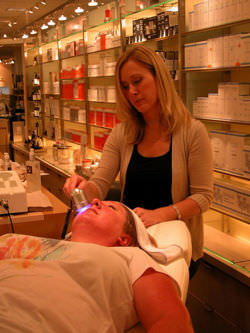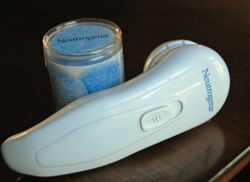Von den beiden Hautbehandlungsverfahren ist das chemische Peeling eine relativ teurere und invasivere, aber länger anhaltende Methode. Mikrodermabrasion ist eine billigere, nicht-chirurgische Alternative, obwohl ihre Wirkung nicht so lange anhält. Beim chemischen Peeling wird eine chemische Lösung verwendet, während die Mikrodermabrasion entweder mit einem Handgerät oder einem Diamantstab durchgeführt wird.
Vergleichstabelle
| Chemisches Peeling | Mikrodermabrasion | |
|---|---|---|
| Uses | Exfoliate the skin using chemical solution to treat sun exposure, acne, wrinkles , freckles, irregular pigmentation and scars. | Treat light scarring, discoloration, sun damage, or to lessen the appearance of stretch marks. |
| Average Cost | $750 – $850 | $150 |
| Introduction (from Wikipedia) | A chemical peel is a procedure to improve and smooth the texture of facial skin using a chemical solution that causes the dead skin to slough off and eventually peel off. | Microdermabrasion is a non-surgical procedure to rejuvenate the skin using a handheld device or a diamond-tipped wand.. |
| Procedure | Chemical solutions are applied to the skin to remove the outer layers then washed off. | The hand piece emits crystals onto the surface of the skin, resulting in a gentle abrasion or “polishing” process. |
| Side effects | Redness, swelling, burning, scarring, peeling, infection, abnormal pigmentation. | Photosensitivity, skin tightness, bruising and redness |
| Longevity | Long lasting; a light chemical peel can last months, even years; the effect of a deep chemical peel can be apparent up to 20 years later. | Short-lived; must be done frequently to maintain the effects. |
| Recovery period | 6 weeks (Deep chemical peel) | Immediate recovery |
Uses
Chemical peel, also known as chemexfoliation or derma peeling, uses a chemical solution to smooth the texture of skin by removing the damaged outer layers, so as to peel the dead skin off. It can be used to treat sun exposure, acne and wrinkles .

Microdermabrasion
Microdermabrasion is mainly used to treat light scarring, discoloration, sun damage, or to lessen the appearance of stretch marks using an anesthetic; the procedure rejuvenates the skin without the need of surgery.
Process
In a chemical peel, chemical solutions of phenol, tricholoraecetic acid and alphahydroxy acids are applied to the skin to remove the outer layers. For light chemical peels, after the face is cleansed , the solution is brushed onto the skin and left for up to 10 minutes. It is then washed off and neutralized. Deep chemical peels involve pre-treatment, where Retin A is prescribed to thin out the skin’s surface layer. You are given a sedative and local anesthetic, and the chemical can stay on the skin from 30 minutes to two hours. A thick coat of petroleum jelly is applied, which must stay in place for up to two days.
There are two kinds of microdermabrasion treatments; one using a handheld device and the other that uses a diamond-tipped wand. Tiny grains of crystals, diamonds and bristle tips are applied to the skin to peel off the topmost layer. The process does not use needles or anesthetic, and takes about two to 60 minutes. It can be done at home with special facial scrubs, or by a machine that uses a pressurized pump to sodium chloride, aluminum oxide, magnesium oxide and diamond crystals to the skin.
A Visual Walkthrough
These videos will give you an idea about what to expect before, during and after these procedures:
Chemical Peel
What to Expect when receiving a Chemical Peel
<iframe width=”640″ height=”360″ frameborder=”0″ allowfullscreen src=”https://www.youtube.com/embed/9QPMYvGK5Qo?iv_load_policy=3&rel=0″></iframe>
What to Expect after a Chemical Peel
<iframe width=”640″ height=”360″ frameborder=”0″ allowfullscreen src=”https://www.youtube.com/embed/GC7fOAUnNe8?iv_load_policy=3&rel=0″></iframe>
What to Expect in a Microdermabrasion Procedure
<iframe width=”640″ height=”360″ frameborder=”0″ allowfullscreen src=”https://www.youtube.com/embed/bFjN1V5BBUM?iv_load_policy=3&rel=0″></iframe>
A microdermabrasion has minimal side effects and normal activities can be resumed immediately.
Advantages
Chemical Peel:
- Effects of a phenol chemical peel are long lasting, and in some cases are still readily apparent up to 20 years following the procedure. Improvements in the patient’s skin can be quite dramatic.
Microdermabrasion:
- Microdermabrasion has very mild, virtually no side effects.
- Gives the skin an overall fresh, healthy-looking glow. It’s a safe, nonsurgical, effective “lunch hour” procedure.
- Effective on all skin colors and types.
- No anesthetic required.
- Excellent for skin sensitive to chemical procedures.
- Normal activities can be resumed immediately.
Disadvantages and Side Effects
Possible postoperative complications of chemical peeling can include scarring, infection or abnormal pigmentation. It tends to have a bleaching effect, and patient may need to wear make-up to match treated and untreated areas. Skin pores may appear larger, and the skin may not tan properly. Medium chemical peels can cause burning or stinging and may turn the skin red or brown for a few days. Deep chemical peels involve peeling, redness and discomfort for several days. There is often swelling, and the skin can remain red for up to three months. Those with certain skin types may see a temporary or permanent change in their skin color after a chemical peel, especially if they use birth controls, become pregnant or have a family history of brownish discoloration. There is also the risk of hyperpigmentation or infection.
Side effects from microdermabrasion include photosensitivity, skin tightness, bruising and redness.
Restrictions
EKG monitoring is advised for people considering a chemical peel. Deep chemical peel patients should not return to work or wear makeup for two weeks after treatment; it may take an additional four weeks for the skin to return to normal.
Mirodermabrasion is available for patients between 12 and 65. The procedure requires multiple sessions and maintenance treatments, and an individualized skin care program may be recommended to maximize results.
Longevity of treatment
With good sun protection, the effects of a chemical peel can last for months or years, depending on the depth of the peel. However, hormonal changes, sun damage and acne breakouts can cause new changes in the pigment or new scarring.
Microdermabrasion must be done frequently to maintain the effects. Experts recommend between six to twelve sessions, one every one to two weeks, for the best effects, followed by one a month for maintenance.
Cost of a Chemical Peel vs Microdermabrasion Procedure
On an average, chemical peel costs between $750 and $850. Additional fees may include anesthesia fees and surgical facility costs. Most health insurance does not cover chemical peels.
The average fee for microdermabrasion is $152.
Home Solutions

Neutrogena Home Microdermabrasion System
While procedural chemical peel and microdermabrasion may require time, effort and money, the beauty and cosmetic market has introduced more affordable home solutions for chemical peels as well as microdermabrasions. Several chemical peel kits or microdermabrasion systems by some of the most popular brands in beauty and skin care are currently available in the market, as seen in the section below:
Where to Buy
The Amazon Best Sellers list for facial treatment products is a good place to start when looking for products for home treatment.
References
- Wikipedia: Chemical peel
- Chemical Peel – plasticsurgery.org
- Chemical Peels – womensandfamilycare.com
- Microdermabrasion – peelsmd.com
- Microdermabrasion – plasticsurgery.org
- Deep Chemical Peel – surgery.org
- Microdermabrasion – surgery.org